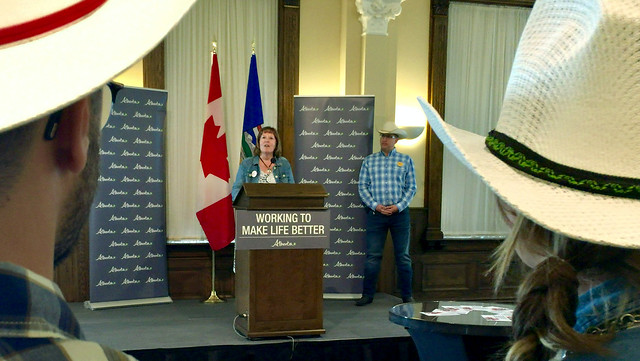This release was issued under a previous government.

Minister McCuaig-Boyd addresses industry leaders and stakeholders at the annual Stampede Energy Open House at McDougall Centre.
Premier Rachel Notley and Energy Minister Margaret McCuaig-Boyd have been standing up for Alberta and fighting for pipelines. Thanks to their leadership, Alberta is now closer than ever to breaking the land lock and getting top dollar for our natural resources. That strong, positive message was delivered to industry leaders during the annual Stampede Week Energy Open House.
“We’re an energy province – we always have been and always will be. Our made-in-Alberta plan has put us ahead of the curve as a sustainable energy producer the world needs for the 21st century. It means new pipelines, more good jobs and building a cleaner, more diversified energy sector. There’s more work to do, but I’m incredibly optimistic because we’re seeing more Albertans going to work and benefiting from the oil and gas resources we’re so blessed to have. That’s making life better for everyday families.”
Upstream energy sector employment went up three per cent in 2017, pushed by production increases of 12 per cent in crude bitumen, eight per cent in conventional oil and two per cent in natural gas. These numbers were driven by dramatic increases in drilling activity and new oil sands operations coming online.
The job gains are expected to continue through 2018 and into 2019 as government focuses on implementing further rounds of the Renewable Energy Program in the electricity sector and accepting applications for three programs under the Energy Diversification Act. Collectively, these programs will attract billions of dollars in private sector investment in petrochemicals, partial-upgrading and clean energy development.
While the energy sector continues to improve, government remains committed to addressing the issues facing industry. The on-going Keep Canada Working public advocacy campaign will continue over the summer, helping educate Canadians about the importance of the energy sector to Canada and the need for the Trans Mountain Pipeline expansion project. Since the campaign began, it has reached millions of Canadians through multiple channels with online videos being viewed more than a million times.
Securing increased market access is a priority for the government so it can help ensure the oil and gas sector remains competitive. The province is also working with industry to examine natural gas market access issues and how it can support increased rail transportation while pipeline construction is ongoing.
Government and the Alberta Energy Regulator are also studying the regulatory and permitting process to reduce the time spent reviewing projects. This will help make Alberta industry more competitive by saving hundreds of millions of dollars in costs related to review times while maintaining strong environmental oversight. More information on this review will be available in the coming weeks.
Quick facts
- In 2017, direct employment in the upstream energy sector in Alberta was about 140,000 people, a three per cent increase from the 136,000 employed in 2016.
- Crude bitumen production increased about 12 per cent to 2.83 million barrels per day in 2017 from 2.54 million in 2016.
- Production of conventional crude oil and equivalents increased about eight per cent to about 715,900 barrels per day in 2017 from about 665,800 in 2016.
- Marketable natural gas production increased to 10.4 billion cubic feet per day in 2017 from 10.1 billion in 2016, a two per cent increase.
Drilling activity significantly rebounded from 2016 to 2017:
- Total successful natural gas wells drilled increased by 60 per cent to 1,295 in 2017 from 811 in 2016.
- Total successful crude oil wells drilled increased by 119 per cent to 1,831 in 2017 from 836 in 2016.
- Bitumen wells drilled followed a similar trend, increasing by 115 per cent to 1,309 in 2017 from 610 in 2016.
Future program activity:
- Three programs under the Energy Diversification Act are forecast to attract approximately $10 billion in private investment in petrochemical manufacturing and feedstock development and partial upgrading – creating 8,000 direct construction jobs. Applications for these programs are now open.
- The first round of the Renewable Electricity Program successfully attracted about $1 billion in private investment and will create approximately 740 jobs. Rounds 2 and 3 are now underway. In total, the program will attract approximately $10 billion in new electricity investment and create about 7,000 jobs by 2030.